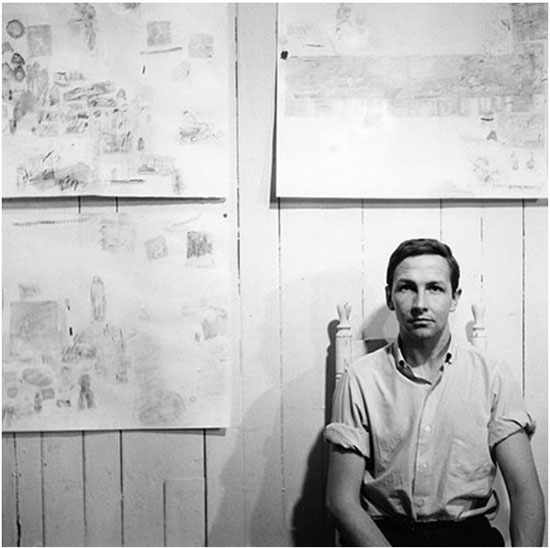A comprehensive survey of Robert Rauschenberg's art is about to embark on an international museum tour launching at Tate Modern and then traveling to the Museum of Modern Art in New York and the San Francisco Museum of Modern Art, announced the Robert Rauschenberg Foundation yesterday.
Opening on December 1, 2016 at Tate Modern and co-organized with The Museum of Modern Art, "Robert Rauschenberg" is the most comprehensive survey of his work in 20 years and the first retrospective of the artist's work since his death in 2008, according to the Robert Rauschenberg Foundation. Distinct presentations of the exhibition will be presented at MoMA from May 21 – September 4, 2017 and the San Francisco of Museum of Modern Art from November 4, 2017 – March 25, 2018.
“It’s the perfect moment to revisit Rauschenberg’s career, given that his impact continues to gain momentum as more and more contemporary artists pay homage to, and are influenced by, various facets of his creative practice and artistic production – from his technology-based artworks and the reuse of images to international collaborations that demonstrated the power of art to spark dialogues between various cultures," stated Christy MacLear, CEO of the Rauschenberg Foundation.
"In the years since Rauschenberg died, we have gained a more nuanced and intimate understanding of both his career and the lasting influence his work has had on artists, spanning his contemporaries to emerging artists today," she continued in the announcement. "We are extremely grateful to Tate, MoMA, and SFMOMA for bringing Rauschenberg’s legacy to life through these monumental exhibitions.”
.

Robert Rauschenberg. Courtesy of the Robert Rauschenberg Foundation.
.
Robert Rauschenberg (1925-2008) has been called a forerunner of essentially every postwar movement since Abstract Expressionism. He moved seamlessly between the mediums of painting, drawing, printmaking, photography, sculpture, installation and performance, and often wove these methods together, blurring the lines between conventional artistic categories and developing a practice that defies simplifications and categorizations.
His open and inclusive approach to art led him to engage in meaningful dialogues with his direct peers, such as Jasper Johns and Cy Twombly, while also collaborating with choreographers, musicians, and even scientists and engineers. Rauschenberg’s global perspective and international footprint—something quite common for artists working today—was revolutionary at the time and demonstrative of his strong belief in the power of art to transcend cultural borders.
"Robert Rauschenberg" will present a holistic and multifaceted overview of the artist’s prolific career. The retrospective will include key examples from his iconic “Combines” series as well as showcase his innovative experiments with media appropriation, technology and performance. The exhibition will also reveal the global impact of Rauschenberg's career, focusing on his close partnerships with artists across Europe, Asia, and Latin America.
Tate Modern’s presentation will begin with an examination of Rauschenberg’s early works, which were largely influenced by his formative years at Black Mountain College, North Carolina, a hub of artistic innovation and experimental practice in the 1940’s and early 50’s. During this period, both found materials and images became integral to Rauschenberg’s visual vocabulary as he began to incorporate newspapers and magazines into his drawings and prints, and perfected techniques of solvent transfer and assemblage.
Beginning in the 1960’s Rauschenberg produced several ambitious artworks incorporating technology, such as the sculptural environment Oracle, 1962-65. Comprised of five elements that Rauschenberg called “gifts from the street,” the sculpture has no fixed composition and emits a range of sounds from radios hidden inside the units.
Tate will present Oracle and other technology-based installations alongside archival photographs and documents from Experiments in Art and Technology (E.A.T.), an organization founded in 1966 by Rauschenberg, artist Robert Whitman, and engineers Billy Klüver and Fred Waldhauer that sought to make technology accessible to artists by facilitating collaborations with engineers.
The retrospective will also highlight and explore Rauschenberg’s work in performance, which was at the core of much of his artistic output. His involvement with performance began with his participation, alongside choreographer Merce Cunningham, in composer John Cage’s "Theatre Piece #1" at Black Mountain College in 1952.
Throughout his career, Rauschenberg not only designed sets, costumes, and lighting for Cunningham and other choreographers such as Trisha Brown and Paul Taylor, but he also performed and choreographed his own works such as "Pelican" in 1963 and "Elgin Tie" in 1964.
By 1970, Rauschenberg left New York and established a home and studio on Captiva Island, Florida, which would become his primary residence until his death in 2008. He continued to work until the end of his life, producing historically significant works throughout his mid to late career, including the Cardboards, 1971-72, Jammers, 1975-76; Gluts, 1986-94; and Anagrams, 1995–97.
"Robert Rauschenberg" at Tate Modern culminates with works from these later series, as well as ephemera from the Rauschenberg Overseas Culture Interchange (ROCI): a 7-year project in which Rauschenberg traveled to ten countries to collaborate with local artists in each region. ROCI became Rauschenberg’s primary preoccupation between 1984 and 1991 and was a tangible expression of his belief in art as a catalyst for global dialogue. Mounting an exhibition of his work in each country – often where freedom of speech and artistic expression had been suppressed – Rauschenberg’s aim was to inspire cross-cultural exchanges and achieve a mutual understanding through art.
The exhibition is accompanied by an illustrated catalogue edited by the exhibition curators–Leah Dickerman and Achim Borchardt-Hume–with essays by Yve-Alain Bois, Andrianna Campbell, Hal Foster, Mark Godfrey, Hiroko Ikegami, Branden Joseph, Ed Krčma and others that focus on specific moments within Rauschenberg’s career. The catalogue will be available at MoMA and Tate stores and online at www.momastore.org and at www.shop.tate.org.uk.
The Rauschenberg Foundation has initiated a Catalogue Raisonné project in tandem with the retrospectives to provide a comprehensive resource of Rauschenberg’s oeuvre. The research and development phase of the project will begin in early 2017. The final catalogue will be published at a date to be announced later.
___________________________________
Copyright 2016 Hamptons Art Hub LLC. All rights reserved.
